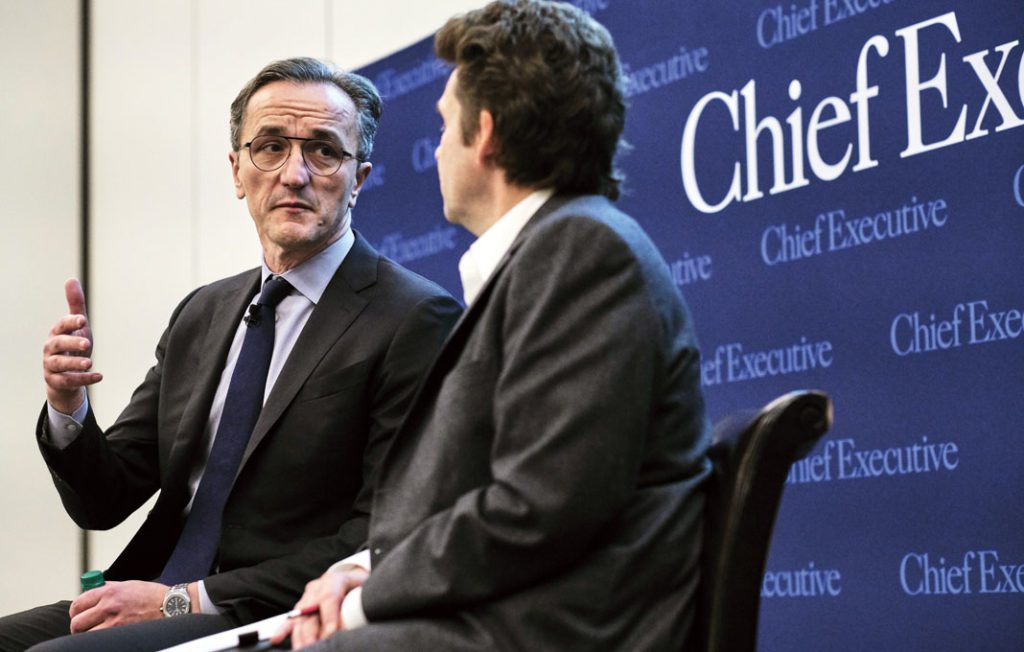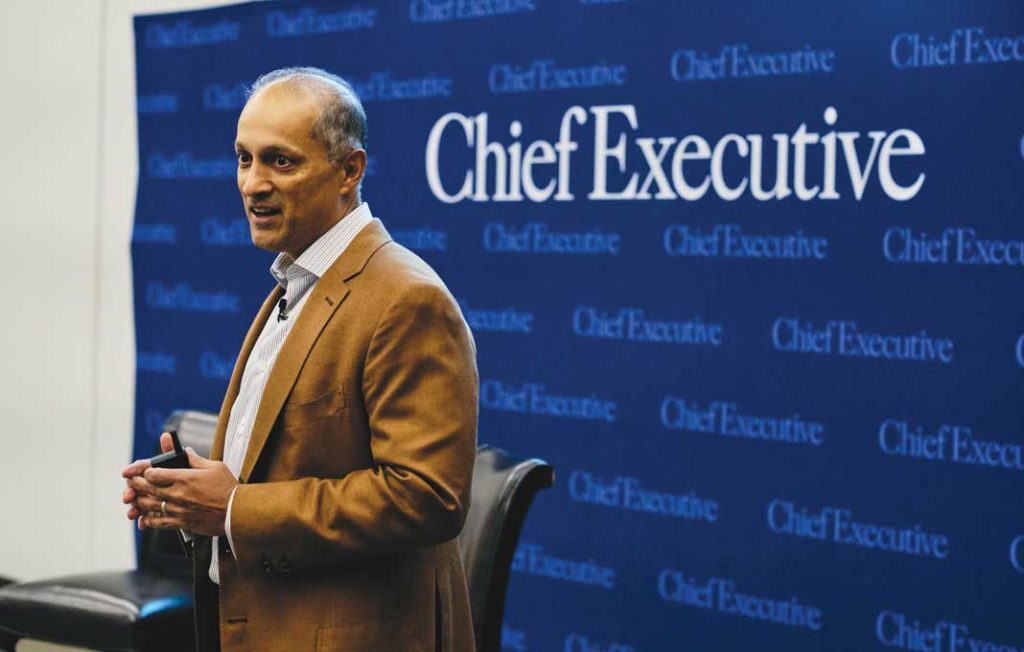
Leading innovation is literally vital for the health industry, as medicine and device manufacturers, care providers, tech companies, insurers and governments scrum in a crucial area of the economy that determines quality of life and longevity for millions of American—and, to a great degree, dictates our progress as a nation.
How to create and harness innovation and effectively disperse its fruits were the subjects of the 2019 Healthcare CEO Summit in Cleveland, held in partnership with Cleveland Clinic, where 50 CEOs from around the country shared experiences and ideas. Given that their industry sits on the cutting edge of so much innovation in this economy, CEOs in nearly any vertical could learn from what they discussed—including the primacy of digital technology in determining the future.
“There’s an explosion of [medical] knowledge and of the ability to share it,” Dr. Thomas Mihaljevic, CEO of Cleveland Clinic, told the conference participants. “It will be the big differentiator for healthcare delivery five years from now.” And while major providers may be able to afford the technology and the capital to harness it, he said, smaller standalone health systems “will need to use economies of scale” just to survive.
Cleveland Clinic has done just that. Now one of America’s biggest healthcare brands, the Cleveland, Ohio-based medical center was a novelty when it was founded in 1921 as a not-for-profit. Every physician remains on one-year contracts. The clinic mastered heart-bypass surgery and made it a springboard for today’s explosive growth that now includes outposts around the U.S. and the world.
It has spun off more than 80 companies in the past decade and is now looking to partner with outside providers to create greater commercial value from its burgeoning storehouse of IP—and, as Mihaljevic put it, “to improve patient outcomes and as many lives as possible.”

Stryker has nearly doubled revenues to about $15 billion over Kevin Lobo’s nine years as CEO of the Kalamazoo, Michigan-based medical-devices giant, by combining the benefits of a culture of innovation with an aggressive acquisition strategy. The company, which makes everything from cranial implants to inflatable heel boots, looks for add-ons that “fit right into an existing business,” said Lobo, who also has been Stryker’s chairman since 2014. “We want to bolster and strengthen our position wherever we play. We want to be absolute leaders in the field.”
R&D competence is central to that acquisition ethos because, “if you don’t have [that], how can you assess what’s a good technology and what’s not?” he said. The company spends about 6.5 percent of its revenue on R&D.
Lobo also continually scours the world in search of external opportunities, preferably “de-risked” buys. “I’d rather pay more money for something that works,” he said. The company can scoop up the brainchilds of small, innovative companies and leverage its expertise to fine-tune and manufacture at scale.
At the same time, Lobo allows each division of the company a fair amount of functional autonomy, in part to be as innovative as possible. “It’s a culture of being driven, focused on sales growth that’s focused on your customer,” Lobo explained.
Each division is empowered to sniff out its own deals and present the possibility to headquarters. “The question is, can they make the economics and the business model work?” Lobo said. “And if we pass on something at corporate, they know they can just come back the next week with another deal.”
Quanterix launched one of the most successful IPOs in recent history for a life-science tools company, in 2017. But it wasn’t the chance to create 10X value through commercial disruption that got CEO Kevin Hrusovsky most juiced. Instead, he points to a “greater purpose”: helping people live better and longer lives. Purpose is inextricably linked to profits, Hrusovsky said, because it helps operationalize the innovation that is the lifeblood of any science-based company, especially one like Quanterix, which digitizes biomarker analysis to advance precision health. “You feed technologies that feed into your purpose,” he said.
“Creating excitement within the business is really easy for people in [life sciences] because we can link what we’re doing to extending life expectancy, reducing pain and bringing more productivity to life,” he acknowledged. “When you’re making toothpicks, that may be a little harder.”
However, some aspects of the company’s culture that play a crucial role in enabling and optimizing innovation can translate to any organization:
Emphasizing accountability, teamwork and trust. “I used to be driven by financials,” he said, “but now everything I do is emotional stuff. I try to surround myself with people I can trust to execute.”
Vigilantly vetting prospective employees. Would-be newcomers are given carte blanche access to Hrusovsky for six months, with full access to relevant information via email before being hired, to ensure that they’ll fit into the team. Hrusovsky is also adamant about fending off fiefdoms within the company. “We don’t allow anyone to divide and conquer down low,” he said.
Adopting innovation accountability. Quanterix enforces accountability as a precondition for the zest to innovate, Hrusovsky said, but it doesn’t condemn failure per se. “If someone stands up and says, ‘I screwed up,’ they might get an award,” he said. “You can’t point to someone else’s failure; everyone has issues.”
Vibrant messaging on culture. Quanterix training employs lots of animal metaphors to illustrate cultural memes. The company urges employees to act like “canaries” to spot issues early and move collectively like “minnows when a predator comes,” the CEO said.
“We note how a lobster has to shed its shell to grow and then is incredibly vulnerable” for a while, Hrusovsky said. “The point is that if you don’t point out your weaknesses, we can’t trust you.”
 The new boss in the healthcare industry is the consumer, thanks to changes in technology, culture and economics. And this growing primacy of the patient is creating new, multi-billion-dollar market opportunities, a diverse panel of healthcare executives told the conference.
The new boss in the healthcare industry is the consumer, thanks to changes in technology, culture and economics. And this growing primacy of the patient is creating new, multi-billion-dollar market opportunities, a diverse panel of healthcare executives told the conference.
“This is both good news and a challenge,” said Michael Crupain, chief medical officer of Sharecare, an Atlanta-based online health-and-wellness platform co-founded by Mehmet Oz of The Dr. Oz Show fame. “The good news is that the consumer is more interested in understanding health [and] is taking much more ownership.” But as Rita Johnson-Mills, former CEO of UnitedHealthcare Community Plan of Tennessee put it, “We’re giving consumers access to far more information, but no one is really deciphering it and providing education around what it means.”
For example, new toothbrushes with sophisticated sensors can tell patients where they brushed—and did not brush—their teeth and then link that information to electronic medical records. “That’s exciting, said Stanley Bergman, CEO of Henry Schein, a distributor of healthcare products, “but first we need to make sure the public understands it’s important to brush your teeth.”
Other challenges include the fact that caches of medical record information repose in incompatible digital formats owned by a variety of independent—and sometimes hostile—organizations. Obstacles range from CEOs’ concerns about cybersecurity to doctors’ worries about malpractice suits to industry concerns about a “digital divide” that would leave out populations, such as the elderly, who are often uncomfortable with electronic records. “The technology exists to solve this issue, so we have to do it,” Johnson-Mills said.
Neither has the healthcare industry been able to help Americans realize the potential of wellness care. “We need to focus much more on public health,” Bergman said. “Taking care of the environment where people live is far more important than giving them another prescription.”
Before Silicon Valley got caught up in controversy over how it uses its endless troves of information about individuals, digital-tech outfits became known for building workplace cultures that were highly effective in creating innovations that changed the world. As former head of people operations at Google, Laszlo Bock was a pioneer in that endeavor.
And now, as CEO of tech startup Humu, Bock is trying to help companies maximize employee happiness and organizational health using AI and behavioral psychology. Part of that entails busting myths like the one holding that “high-performing teams are comprised of smart, diverse, proven performers.”
Instead, Bock offered, the culture of corporate teams is more important than their composition, and they succeed based on five pillars: First, “psychological safety,” which allows members to speak up freely. Second, dependability—to the point where “you don’t even have to assign things” because team members organically do what needs to be done. “Structure and clarity,” “meaning” and “impact” are also key.
Driving cultural change that affects performance often fails with conventional methods, such as leadership training, individual coaching and corporate “academies,” said Bock, who suggested leaders work to gauge truly how employees are feeling and use “nudging” to influence behavior.
One way to get employees to do more of what’s good for them is by making it easier. In the Humu cafeteria, management put junk food items in opaque containers to dampen their merchandising allure. Consumption plummeted.
“We didn’t restrict choice or force anything,” Bock said. “We just offset the alluring power of the shiny bright things that are literally designed to make you consume garbage.”

Chief Executive Group exists to improve the performance of U.S. CEOs, senior executives and public-company directors, helping you grow your companies, build your communities and strengthen society. Learn more at chiefexecutivegroup.com.
0

1:00 - 5:00 pm
Over 70% of Executives Surveyed Agree: Many Strategic Planning Efforts Lack Systematic Approach Tips for Enhancing Your Strategic Planning Process
Executives expressed frustration with their current strategic planning process. Issues include:
Steve Rutan and Denise Harrison have put together an afternoon workshop that will provide the tools you need to address these concerns. They have worked with hundreds of executives to develop a systematic approach that will enable your team to make better decisions during strategic planning. Steve and Denise will walk you through exercises for prioritizing your lists and steps that will reset and reinvigorate your process. This will be a hands-on workshop that will enable you to think about your business as you use the tools that are being presented. If you are ready for a Strategic Planning tune-up, select this workshop in your registration form. The additional fee of $695 will be added to your total.

2:00 - 5:00 pm
Female leaders face the same issues all leaders do, but they often face additional challenges too. In this peer session, we will facilitate a discussion of best practices and how to overcome common barriers to help women leaders be more effective within and outside their organizations.
Limited space available.

10:30 - 5:00 pm
General’s Retreat at Hermitage Golf Course
Sponsored by UBS
General’s Retreat, built in 1986 with architect Gary Roger Baird, has been voted the “Best Golf Course in Nashville” and is a “must play” when visiting the Nashville, Tennessee area. With the beautiful setting along the Cumberland River, golfers of all capabilities will thoroughly enjoy the golf, scenery and hospitality.
The golf outing fee includes transportation to and from the hotel, greens/cart fees, use of practice facilities, and boxed lunch. The bus will leave the hotel at 10:30 am for a noon shotgun start and return to the hotel after the cocktail reception following the completion of the round.